Balkinization
an unanticipated consequence of
Jack M. Balkin
Balkinization Symposiums: A Continuing List
E-mail:
Jack Balkin:
jackbalkin at yahoo.com
Bruce Ackerman
bruce.ackerman at yale.edu
Ian Ayres
ian.ayres at yale.edu
Corey Brettschneider
corey_brettschneider at brown.edu
Mary Dudziak
mary.l.dudziak at emory.edu
Joey Fishkin
joey.fishkin at gmail.com
Heather Gerken heather.gerken at yale.edu
Abbe Gluck abbe.gluck at yale.edu
Mark Graber
mgraber at law.umaryland.edu
Stephen Griffin
sgriffin at tulane.edu
Jonathan Hafetz
jonathan.hafetz at shu.edu
Jeremy Kessler
jkessler at law.columbia.edu
Andrew Koppelman
akoppelman at law.northwestern.edu
Marty Lederman
msl46 at law.georgetown.edu
Sanford Levinson
slevinson at law.utexas.edu
David Luban
david.luban at gmail.com
Gerard Magliocca
gmaglioc at iupui.edu
Jason Mazzone
mazzonej at illinois.edu
Linda McClain
lmcclain at bu.edu
John Mikhail
mikhail at law.georgetown.edu
Frank Pasquale
pasquale.frank at gmail.com
Nate Persily
npersily at gmail.com
Michael Stokes Paulsen
michaelstokespaulsen at gmail.com
Deborah Pearlstein
dpearlst at yu.edu
Rick Pildes
rick.pildes at nyu.edu
David Pozen
dpozen at law.columbia.edu
Richard Primus
raprimus at umich.edu
K. Sabeel Rahmansabeel.rahman at brooklaw.edu
Alice Ristroph
alice.ristroph at shu.edu
Neil Siegel
siegel at law.duke.edu
David Super
david.super at law.georgetown.edu
Brian Tamanaha
btamanaha at wulaw.wustl.edu
Nelson Tebbe
nelson.tebbe at brooklaw.edu
Mark Tushnet
mtushnet at law.harvard.edu
Adam Winkler
winkler at ucla.edu
Compendium of posts on Hobby Lobby and related cases
The Anti-Torture Memos: Balkinization Posts on Torture, Interrogation, Detention, War Powers, and OLC
The Anti-Torture Memos (arranged by topic)
Recent Posts
An Elegy for the Actual Founding Generation
Just A Few Blogs
ACS Blog
Alas, a Blog
Althouse
Arts and Letters Daily
Atrios (Eschaton)
Bill of Health
Buzzflash.com
Buzz Machine
Cato at Liberty
Juan Cole (Informed Comment)
Concurring Opinions
The Constitution in 2020
Corrente
Crooked Timber
Daily Howler
Daily Kos
Dana Boyd
Brad DeLong
Digby (Hullabaloo)
Discriminations
Daniel Drezner
Kevin Drum (Mother Jones)
Electrolite
En Banc
Eunomia (Daniel Larison)
Fafblog
Michael Froomkin (Discourse.net)
GovLab (Beth Noveck)
Rick Hasen (Election Law)
History News Network
How Appealing
Ignatz (Sam Heldman)
The Importance of (Ernie Miller)
Infolaw
Instapundit
International Economic Law and Policy Blog
IntLawGrrls
Jacob Levy
Jesus' General
Jurisdynamics
The Kitchen Cabinet
Mark Kleiman
Law Blog Central
Larry Lessig
Lawyers, Guns and Money
Liberal Oasis
Brian Leiter's Law School Reports
The Leiter Reports
Marginal Revolution
Megan McArdle
Memeorandum
Metafilter
Mirror of Justice
The New Republic
Newseum
No More Mister Nice Blog
Brendan Nyhan
Opinio Juris
Orcinus
The Originalism Blog
Pandagon
Passport (Foreign Policy)
Overcoming Bias
Political Animal (Washington Monthly)
Political Theory Daily Review
Political Wire (Taegan Goddard)
The Poor Man
Virginia Postrel
Prawfsblawg
Public Reason
Jonathan Rauch
Raw Story
Redstate
ReligiousLeftLaw.com
Reporters Committee For Freedom of the Press
Reproductive Rights Blog
Rothman's Roadmap to the Right of Publicity
SCOTUS Blog
Seeing the Forest
Clay Shirky
The Shifted Librarian
The Situationist
Larry Solum (Legal Theory)
Andrew Sullivan
Talking Points Memo
Talk Left
Tapped
Tbogg
TechPresident
The Paper Chase (Jurist)
Tom Paine
Tom Tomorrow (This Modern World)
Eve Tushnet
Uggabugga
University of Chicago Law School Faculty Blog
Unqualified Offerings
The Volokh Conspiracy
War and Piece (Laura Rozen)
Wampum
Oliver Willis
Wonkette
Written Description
Matthew Yglesias
Yin
Your Choice of Feeds
1. XML
powered by
2. Atom Feed
3. RSS 2.0
An Elegy for the Actual Founding Generation
Guest Blogger
For the Balkinization symposium on John Witt, The Radical Fund: How a Band of Visionaries and a Million Dollars Upended America (Simon and Schuster, 2025). Aziz Rana John Witt’s superb The Radical
Fund tells the interwar story of the Garland Fund, a relatively small
institution endowed by an idealist young socialist named Charles Garland, which
nonetheless played a dramatically outsized role in bringing together key
reformers, organizers, lawyers, and politicians across the era’s broad American
left. The Fund itself has an almost Zelig-like quality, intersecting at some
point with seemingly every major activist in the 1920s and 1930s on behalf of
racial equality, labor rights, and civil liberties. In narrating the history of
the Fund, Witt ultimately narrates nothing less that the birth of the United
States itself—certainly the birth of the version of the country many Americans
today embrace as their own. The book is thus a profound and incredibly moving
testament to the collective efforts and achievements of the individuals who, in
many ways, are the actual founding generation of the modern United States. In popular culture, there persists a
tendency to think of the country as having a single, unbroken constitutional
project, from the eighteenth century to the present. In this account, later
achievements are part of an unfolding liberal essence, whose germ was already
present in the 1780s. Yet, in truth, the constitutional compact Americans, who
came of age by the end of the twentieth century, have lived under bears little
relation to the commitments and cultural world of Hamilton and Madison. The
twentieth century compact linked together a series of ideological commitments
that fundamentally broke with the eighteenth and nineteenth century defenses of
explicit white supremacy and labor oppression. This new compact entailed a
reading of the Constitution as grounded in racial inclusion and the legal
overcoming of Jim Crow; an anti-totalitarian commitment to civil liberty and
speech rights; a defense of market capitalism, but one hedged in by an
entrenched regulatory and social welfare state; an embrace of institutional
checks and balances, with the Supreme Court as a reformist participant; and a
vision of US power as promoting these same internal values globally. In returning us to the world of the
1920s, The Radical Fund reminds the reader of what an unfamiliar country
the United States was not so long ago. His cast of reformers exist in a society
of brutal white violence and the ever-present specter of lynching, alongside
extreme economic immiseration and private armies sent by business to wage actual,
not metaphorical, war on labor. These
reformers are thus participants in a broad legal, economic, political, and
cultural turn, and embody the generational hinge between a nineteenth century order
and the one many American now would recognize.
The
post-Cold War years of the 1990s and 2000s saw an endless stream of hagiographies
to the eighteenth-century revolutionary elites, with Lincoln added into the mix.
In recounting the history of the Garland Fund and in honoring the life’s work
of those involved, I see Witt’s book as a vital and beautifully written contribution
to a new cultural repository. This repository speaks far more authentically to American
achievement. Indeed, books such as this one—especially so grippingly told—are worthy
in own right of memorialization through popular art, musicals and film, like
the 1990s and 2000s hagiographies. The
Radical Fund
proceeds with a deep spirit of optimism. If anything, the book’s implicit mood often
verges on a sense of triumph, despite the fact that its time period was a low
point for the American left. Many radicals understood the 1920s—given the
effects of the first Red Scare, the rise of the second Ku Klux Klan, and the
broader climate of violent reaction—as years of defeat and despondency. Union membership declined; circulation for
the NAACP’s The Crisis dropped to less than a third of its 1919 peak; A.
Philip Randolph’s Black socialist The Messenger ceased operation
entirely by the end of the decade. Charles Garland himself collapsed into deep
depression, at least in small part impacted by dashed hopes. Still,
Witt’s focus on the Fund, during this era of retrenchment, teases out the early
building blocks of what would become the defining legislative, judicial, and
cultural victories of New Deal and Civil Rights eras. We meet numerous figures, essentially before
they gained real political power by the mid-century, who would eventually steer
a very different American state. And the
reader’s knowledge of these victories to come gives a political ebullience to revisiting
the 1920s. It even stiffens one’s sense of optimism about moments like our own.
Perhaps, just as radicals then did not know that a new world was around the
corner, we too in the face of authoritarian reaction may not be able to see the
emancipatory changes on the horizon. It is a remarkable and worthy achievement—a
real gift to readers—to offer both an honest assessment of structural injustice
while sustaining one’s hope even in difficult times. Yet,
for all its near-triumphalism, I could not help but read the book as an elegy
for the American twentieth century, given the path the country has travelled
since the 1920s. If Witt describes the beginning of a transformation, Americans
now in many ways live at the historical breakdown of that mid-twentieth century
compact. Trumpist politics amounts to a systematic assault on all the
constituent elements of the order built by past reformers—from racial
liberalism and basic civil liberties to the New Deal state and the Supreme
Court as a reformist guide. Just
as significantly, The Radical Fund’s story implicitly highlights how the
infrastructural currents within which an ecumenical interwar left swam—the
unions, the worker schools, the Black political organizations and churches, the
political parties, the civic associations—have all receded under the weight of
a half-century of neoliberal economic reorganization and profound cultural
change. 1920s leftists may have been disheartened that the social revolution
they anticipated had not arrived, but even during a time of reaction and seemingly
declining numbers they operated in a context of extensive intermediate
institutions. These institutions shaped
the schools, workplaces, and neighborhoods of a multi-racial U.S. working
class. Mass organizing and movement-building since the Civil War meant that
left ideas—even if under 1920s assault—were organically embedded in the
everyday experiences of countless Americans. The roots had been planted for the
burgeoning of a latent and massive political majority. In a sense, Americans
today live at the other end of a historical horizon, in no small measure due to
how dramatically the political terrain—one that the Garland Fund both benefited
from and helped to expand—has been reconstituted. For
this reason, Witt’s book can offer more questions than answers when it gestures
toward a theory of social change. One is left to wonder why this fund, again
without that large of an endowment, time and again seemed linked to the figures
and movements that between the 1930s and 1960s would reshape the United States
on liberal grounds. Witt seems to shift between two potential responses. He is
more convincing when he treats the Fund as an expression of movement vitality.
In those moments in the book, he emphasizes how the Fund was an open space for
an incredibly rich and variegated American left—from communists and anarchists
to democratic socialists and eventual New Deal liberals. As Witt writes, unlike
the philanthropic enterprises generated by business oligarchs such as the
Carnegies—who used largess in part to legitimate their economic power—the Fund’s
benefactor and directors were of the left. They thus shaped their institution in the
mold of the left’s cultural world. And for this reason, the Fund lived “on both
sides of an essential and inescapable conflict” between revolution and reform, in
the process “host[ing] debates among progressives, liberals, social democrats,
socialists, and Communists” (497). Thus,
the success of the Fund was not necessarily due to the steering wisdom of the
directors, or their special foresight in how best to guide the society.
Instead, it was because the Fund maintained contact with all the messiness and
internal contradictions of the left’s overlapping institutions. The result was
that it gave sustenance to movement actors broadly speaking, with both striking
victories and false turns as evidence. Yet,
at times, Witt appears to embrace precisely a vision of change that emphasizes the
Fund directors’ guiding knowledge. He can depict its central figures, like
Roger Baldwin, as holding together a moderate middle that time and again seems
to know just how to balance between what he castigates as a “wild-eyed IWW” (351),
along with similarly irresponsible communists, on the one side, and the dominant
forces of the status quo on the other. In this way, Witt can occasionally use
language—“the race question surged to the fore of the Fund’s deliberations in a
way that reshaped the future of America democracy” (326); “What happened next
helped alter the life trajectory of the man [A. Philip Randolph] that would
become the most influential Black union organizer in the twentieth
century”—that make his Fund heroes seem almost like the invisible movers of all
social change. One
consequence of this latter tendency is that the book largely avoids interrogating
the limits of the board’s politics when that politics coincides with what
readers today would see as American liberalism’s conventional wisdom. And by
the same token, almost all the criticism of the Fund’s choices is when it sides
with views Witt depicts as emblematic of the less responsible left. Witt may
well be correct about these assessments. But it does mean that the book refrains
from the thorny matter of whether from our vantage point—at the end of
the long twentieth century—the liberal mainstream is at all implicated in the
crises of the present. Did the mid-century constitutional compact unravel in
part due to its own instabilities and internal weaknesses or should the only
goal for the future be restoration? One clear site of potential liberal
self-examination would have been the question of foreign policy and American
empire, issues in the present that have roiled the Democratic party and its
coalition. But Witt treats in only two sentences the fact that Baldwin, in
keeping as well with the ultimate direction of the ACLU, abandoned
anti-imperialism: “Baldwin did adopt some general guidelines. The Fund would
focus on America projects rather than international or foreign ones”
(110). The matter is left there. This is
even though such a choice pushed against the desire of many radicals, like ACLU
co-founder Crystal Eastman, to link anti-imperialism to anti-racism and
anti-capitalism, and to treat the foreign as inextricably joined to any effort
at domestic transformation. This silence avoids grappling with the long-term implications
American liberalism’s cleaving of the foreign and the domestic, in ways that
would have profound effects on Cold War America. By the 1950s, it was precisely
questions of the US in the world, embedded in the debates about decolonization
and Soviet rivalry, that would both lead to the systematic repression of left
critics of the Cold War and play a significant role in containing domestic
reform horizons. But
ultimately, my wariness of this strain in the book is not about re-litigating
strategic choices between competing, if shifting, left-liberal blocs. It is a
concern that the idea of the Fund—at its best—as a wise and moderating change
agent can direct the reader away from appreciating both what lessons to draw
about social change today and why his reformers are genuine heroes. Witt
ends the book by noting the number of extremely wealthy people in 2025 who
could invest in a similar philanthropic enterprise. This is a worthy call and
certainly such money could have truly productive effects. But the Garland Fund
story doesn’t really suggest that having the wealthy fund good causes is
necessarily the pathway to change, especially if those efforts aren’t located
in a rich cultural world. For starters, it is a very high bar to expect even
truly well-meaning fund directors to get right the key strategic choices. Again,
the Zelig-like success of the Fund was due less to the money and its
distribution, and far more to the depth of left infrastructural life at the
time. Baldwin himself when assessing their strategic choices felt that the Fund
got it wrong more often than not: “we often merely gave blood transfusions to
agencies already headed for the grave” (531). But in an era of extensive left
experimentation and institutional depth—despite reactionary headwinds—the Fund’s
margin of error was incredibly large. Thus, from today’s perspective, Baldwin’s
more pessimistic assessment misses how the group, by being of the
left—again in all its internal tensions—and by seeding the left generally,
seeded sites too that would flourish. The takeaway for the present, which Witt
clearly agrees with too, highlights the importance of rebuilding a cultural
world within which a vibrant left can grow, including through critical funding. Finally,
deemphasizing the matter of their strategic wisdom suggests another ground for
viewing the book’s figures—Roger Baldwin, Sidney Hillman, A. Philip Randolph,
James Weldon Johnson, Charles Garland, W.E.B. Du Bois, Charles Hamilton
Houston, and Elizabeth Gurley Flynn, to name a few—as both American founders and
American heroes. In reading The Radical Fund, I was struck, repeatedly,
less by where these figures stood in the internal left debates of the 1920s and
far more by the type of American cultural class that they embodied. Many of
these individuals—black and white, men and women—were, for all intents and
purposes, part of that era’s elite, given education, wealth, social standing,
and leadership status within organizations. A striking number of them even attended
or taught at Harvard, well before the institution’s broader middle-class,
religious, racial, and gender accessibility.
Yet,
at the same time, these were individuals, including from patrician backgrounds,
who expected to face repression and chose paths that meant prison, criminal
prosecution, death threats, and even the potential of white lynching. The
number of these figures that went to jail is notable, starting with both
Charles Garland and Roger Baldwin. Above all, they took profound personal risks
out of a sense of moral necessity. This fact actually can be missed when
reading the book, because so much of what Witt valorizes in their politics seems
uncontroversial when viewed through today’s liberal eyes. Yet, many of them
fully understood that they inhabited an authoritarian social order in which
dominant powers were opposed to those principles. Contesting that order necessarily
required the willingness to bear intense individual costs. One
profound difference between that era’s reformers and today’s cultural elite—indeed,
our professional-managerial class more generally—is a disconnect between the recognition
of democracy in peril and an existential embrace of the courage necessary to
demand change. It is hardly original to say that for future generations today’s
threats, at home and abroad, to basic rights and democracy—from the immigration
prison to Gaza—will be as self-evident as when we view the 1920s fight against
Jim Crow and labor exploitation. And so, perhaps the main reason I experience
this book as an elegy is because it forces me to confront the heroism of the
past as well as the very different internal sensibilities and calculations of
today’s cultural elite—all of us included. The question of the day is whether
we can muster anything approaching the same existential reserves to be worthy
inheritors of their legacy. Aziz
Rana is the J. Donald Monan, S.J., University Professor of Law and Government
at Boston College. He can be reached by
email at ranaaz@bc.edu.
Posted
9:30 AM
by Guest Blogger [link]
Books by Balkinization Bloggers

Gerard N. Magliocca, The Actual Art of Governing: Justice Robert H. Jackson's Concurring Opinion in the Steel Seizure Case (Oxford University Press, 2025)

Linda C. McClain and Aziza Ahmed, The Routledge Companion to Gender and COVID-19 (Routledge, 2024)

David Pozen, The Constitution of the War on Drugs (Oxford University Press, 2024)

Jack M. Balkin, Memory and Authority: The Uses of History in Constitutional Interpretation (Yale University Press, 2024)
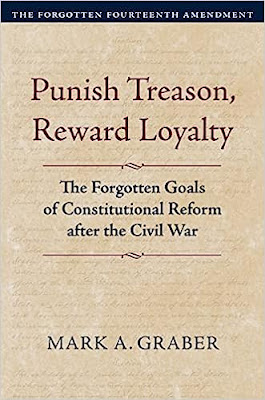
Mark A. Graber, Punish Treason, Reward Loyalty: The Forgotten Goals of Constitutional Reform after the Civil War (University of Kansas Press, 2023)
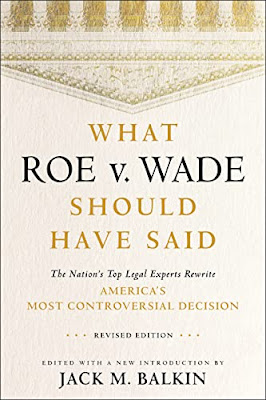
Jack M. Balkin, What Roe v. Wade Should Have Said: The Nation's Top Legal Experts Rewrite America's Most Controversial Decision - Revised Edition (NYU Press, 2023)

Andrew Koppelman, Burning Down the House: How Libertarian Philosophy Was Corrupted by Delusion and Greed (St. Martin’s Press, 2022)

Gerard N. Magliocca, Washington's Heir: The Life of Justice Bushrod Washington (Oxford University Press, 2022)
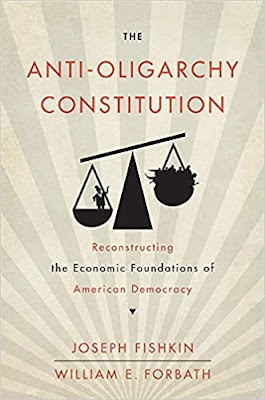
Joseph Fishkin and William E. Forbath, The Anti-Oligarchy Constitution: Reconstructing the Economic Foundations of American Democracy (Harvard University Press, 2022)
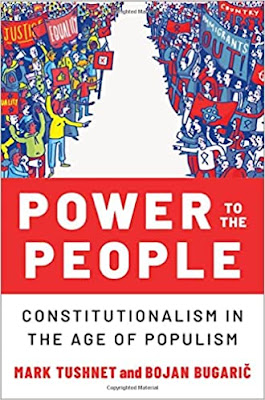
Mark Tushnet and Bojan Bugaric, Power to the People: Constitutionalism in the Age of Populism (Oxford University Press 2021).

Mark Philip Bradley and Mary L. Dudziak, eds., Making the Forever War: Marilyn B. Young on the Culture and Politics of American Militarism Culture and Politics in the Cold War and Beyond (University of Massachusetts Press, 2021).

Jack M. Balkin, What Obergefell v. Hodges Should Have Said: The Nation's Top Legal Experts Rewrite America's Same-Sex Marriage Decision (Yale University Press, 2020)

Frank Pasquale, New Laws of Robotics: Defending Human Expertise in the Age of AI (Belknap Press, 2020)

Jack M. Balkin, The Cycles of Constitutional Time (Oxford University Press, 2020)

Mark Tushnet, Taking Back the Constitution: Activist Judges and the Next Age of American Law (Yale University Press 2020).

Andrew Koppelman, Gay Rights vs. Religious Liberty?: The Unnecessary Conflict (Oxford University Press, 2020)

Ezekiel J Emanuel and Abbe R. Gluck, The Trillion Dollar Revolution: How the Affordable Care Act Transformed Politics, Law, and Health Care in America (PublicAffairs, 2020)

Linda C. McClain, Who's the Bigot?: Learning from Conflicts over Marriage and Civil Rights Law (Oxford University Press, 2020)
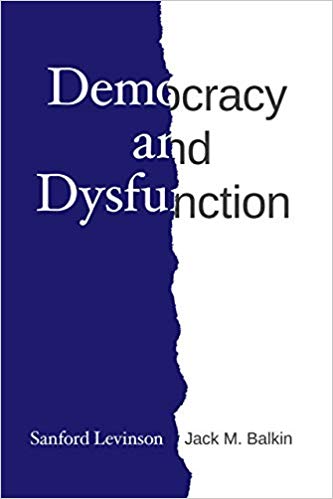
Sanford Levinson and Jack M. Balkin, Democracy and Dysfunction (University of Chicago Press, 2019)

Sanford Levinson, Written in Stone: Public Monuments in Changing Societies (Duke University Press 2018)

Mark A. Graber, Sanford Levinson, and Mark Tushnet, eds., Constitutional Democracy in Crisis? (Oxford University Press 2018)

Gerard Magliocca, The Heart of the Constitution: How the Bill of Rights became the Bill of Rights (Oxford University Press, 2018)

Cynthia Levinson and Sanford Levinson, Fault Lines in the Constitution: The Framers, Their Fights, and the Flaws that Affect Us Today (Peachtree Publishers, 2017)

Brian Z. Tamanaha, A Realistic Theory of Law (Cambridge University Press 2017)

Sanford Levinson, Nullification and Secession in Modern Constitutional Thought (University Press of Kansas 2016)

Sanford Levinson, An Argument Open to All: Reading The Federalist in the 21st Century (Yale University Press 2015)

Stephen M. Griffin, Broken Trust: Dysfunctional Government and Constitutional Reform (University Press of Kansas, 2015)

Frank Pasquale, The Black Box Society: The Secret Algorithms That Control Money and Information (Harvard University Press, 2015)

Bruce Ackerman, We the People, Volume 3: The Civil Rights Revolution (Harvard University Press, 2014)
Balkinization Symposium on We the People, Volume 3: The Civil Rights Revolution

Joseph Fishkin, Bottlenecks: A New Theory of Equal Opportunity (Oxford University Press, 2014)

Mark A. Graber, A New Introduction to American Constitutionalism (Oxford University Press, 2013)

John Mikhail, Elements of Moral Cognition: Rawls' Linguistic Analogy and the Cognitive Science of Moral and Legal Judgment (Cambridge University Press, 2013)

Gerard N. Magliocca, American Founding Son: John Bingham and the Invention of the Fourteenth Amendment (New York University Press, 2013)

Stephen M. Griffin, Long Wars and the Constitution (Harvard University Press, 2013)

Andrew Koppelman, The Tough Luck Constitution and the Assault on Health Care Reform (Oxford University Press, 2013)

James E. Fleming and Linda C. McClain, Ordered Liberty: Rights, Responsibilities, and Virtues (Harvard University Press, 2013)
Balkinization Symposium on Ordered Liberty: Rights, Responsibilities, and Virtues

Andrew Koppelman, Defending American Religious Neutrality (Harvard University Press, 2013)

Brian Z. Tamanaha, Failing Law Schools (University of Chicago Press, 2012)

Sanford Levinson, Framed: America's 51 Constitutions and the Crisis of Governance (Oxford University Press, 2012)

Linda C. McClain and Joanna L. Grossman, Gender Equality: Dimensions of Women's Equal Citizenship (Cambridge University Press, 2012)

Mary Dudziak, War Time: An Idea, Its History, Its Consequences (Oxford University Press, 2012)

Jack M. Balkin, Living Originalism (Harvard University Press, 2011)

Jason Mazzone, Copyfraud and Other Abuses of Intellectual Property Law (Stanford University Press, 2011)

Richard W. Garnett and Andrew Koppelman, First Amendment Stories, (Foundation Press 2011)

Jack M. Balkin, Constitutional Redemption: Political Faith in an Unjust World (Harvard University Press, 2011)

Gerard Magliocca, The Tragedy of William Jennings Bryan: Constitutional Law and the Politics of Backlash (Yale University Press, 2011)

Bernard Harcourt, The Illusion of Free Markets: Punishment and the Myth of Natural Order (Harvard University Press, 2010)

Bruce Ackerman, The Decline and Fall of the American Republic (Harvard University Press, 2010)
Balkinization Symposium on The Decline and Fall of the American Republic

Ian Ayres. Carrots and Sticks: Unlock the Power of Incentives to Get Things Done (Bantam Books, 2010)

Mark Tushnet, Why the Constitution Matters (Yale University Press 2010)
Ian Ayres and Barry Nalebuff: Lifecycle Investing: A New, Safe, and Audacious Way to Improve the Performance of Your Retirement Portfolio (Basic Books, 2010)
.jpg)
Jack M. Balkin, The Laws of Change: I Ching and the Philosophy of Life (2d Edition, Sybil Creek Press 2009)

Brian Z. Tamanaha, Beyond the Formalist-Realist Divide: The Role of Politics in Judging (Princeton University Press 2009)
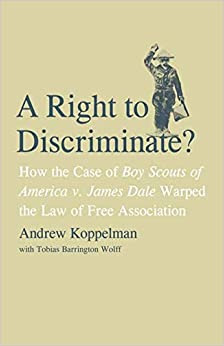
Andrew Koppelman and Tobias Barrington Wolff, A Right to Discriminate?: How the Case of Boy Scouts of America v. James Dale Warped the Law of Free Association (Yale University Press 2009)

Jack M. Balkin and Reva B. Siegel, The Constitution in 2020 (Oxford University Press 2009)
Heather K. Gerken, The Democracy Index: Why Our Election System Is Failing and How to Fix It (Princeton University Press 2009)

Mary Dudziak, Exporting American Dreams: Thurgood Marshall's African Journey (Oxford University Press 2008)

David Luban, Legal Ethics and Human Dignity (Cambridge Univ. Press 2007)

Ian Ayres, Super Crunchers: Why Thinking-By-Numbers is the New Way to be Smart (Bantam 2007)

Jack M. Balkin, James Grimmelmann, Eddan Katz, Nimrod Kozlovski, Shlomit Wagman and Tal Zarsky, eds., Cybercrime: Digital Cops in a Networked Environment (N.Y.U. Press 2007)
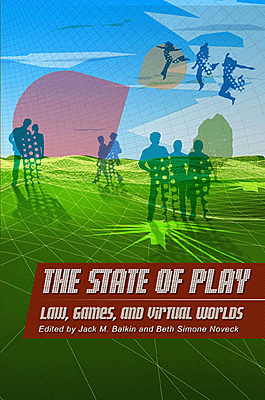
Jack M. Balkin and Beth Simone Noveck, The State of Play: Law, Games, and Virtual Worlds (N.Y.U. Press 2006)

Andrew Koppelman, Same Sex, Different States: When Same-Sex Marriages Cross State Lines (Yale University Press 2006)
Brian Tamanaha, Law as a Means to an End (Cambridge University Press 2006)
Sanford Levinson, Our Undemocratic Constitution (Oxford University Press 2006)
Mark Graber, Dred Scott and the Problem of Constitutional Evil (Cambridge University Press 2006)
Jack M. Balkin, ed., What Roe v. Wade Should Have Said (N.Y.U. Press 2005)
Sanford Levinson, ed., Torture: A Collection (Oxford University Press 2004)
Balkin.com homepage
Bibliography
Conlaw.net
Cultural Software
Writings
Opeds
The Information Society Project
BrownvBoard.com
Useful Links
Syllabi and Exams